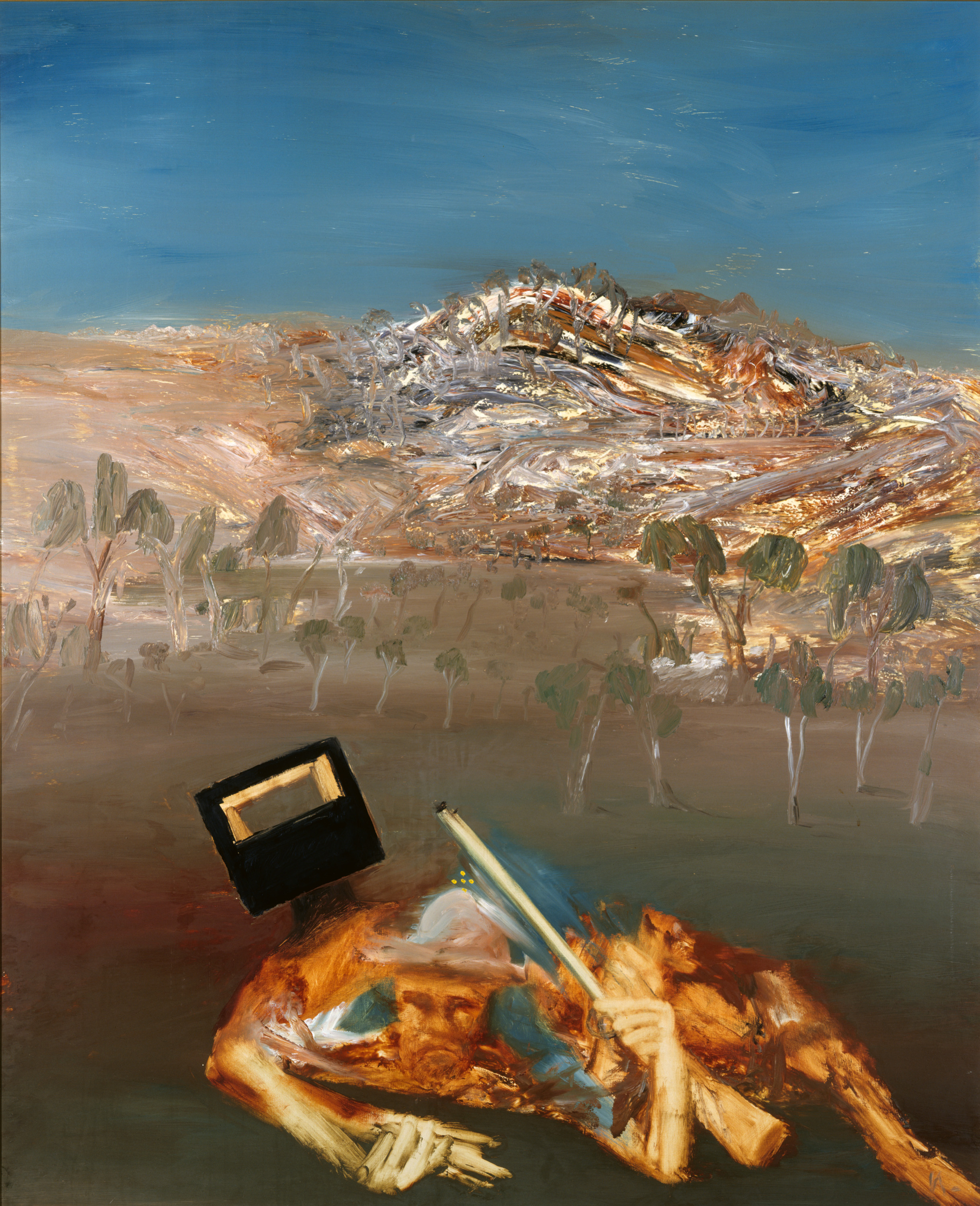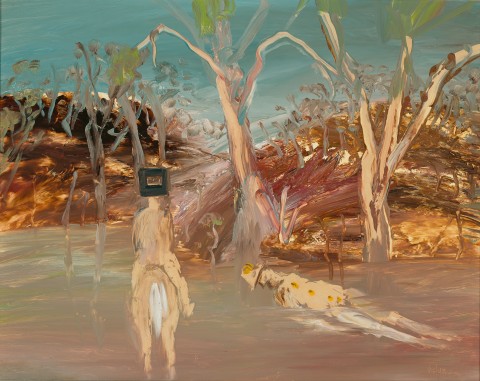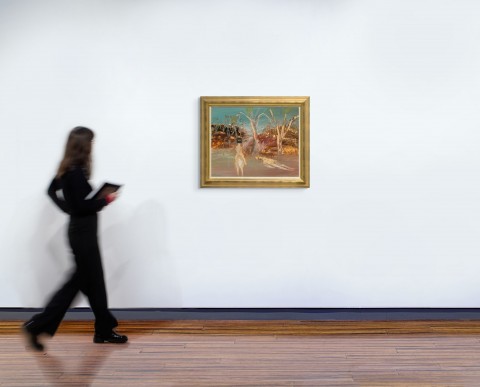KELLY AND FLOATING POLICEMAN, c.1964
SIDNEY NOLAN
oil on composition board
57.0 x 72.5 cm
signed lower right: Nolan
bears inscription on gallery label verso: KELLY + FLOATING POLICEMAN / SIDNEY NOLAN
Australian Galleries, Melbourne (label attached verso)
Private collection, Melbourne, acquired from the above
Policeman floating in the river, 1964, oil on hardboard, 152.4 x 122.9 cm, in the collection of the Art Gallery of New South Wales, Sydney
Kelly and policeman, 1964, oil on hardboard, 152.4 x 121.9 cm, in the collection of the Art Gallery of New South Wales, Sydney
dh220234 SIDNEY NOLAN LH_cmyk.jpg

Sidney Nolan is arguably the most significant Australian artist of the twentieth century. From his earliest works of the 1930s through to major canvases executed in the late 1980s, Nolan’s inventiveness and prodigious output across art, theatre, dance and film made him a renowned figure on the world stage. He was also an inveterate traveller, visiting six continents whilst still retaining his deep connection to his homeland, its history and its legends. Of these, the doomed explorers Burke and Wills, the shipwrecked Eliza Fraser and the Antarctic explorer Douglas Mawson loom large, but it was the iconic bushranger Edward ‘Ned’ Kelly whose story dominated Nolan’s imagination to the extent that he saw him as an alter-ego, such that his colleague Albert Tucker always started letters to Nolan with the words ‘Dear Ned’. Kelly’s story still causes consternation in many quarters but in this infamous figure, the artist recognised a similar defiance and independence – one which animated Nolan’s evolving ruminations on the outlaw. Kelly and floating policeman, c.1964, is an evocative example from the third series, now recognised as the artist’s most personal sequence.
Ned Kelly was born of proud Irish heritage in the small town of Beveridge, north of Melbourne, subsequently moving with his family to Greta, east of Benalla. Following an incident when the drunk Constable Fitzpatrick attempted to seduce his fourteen-year-old sister Kate, Kelly was forced into hiding and his mother Ellen was taken into custody, then jailed as a deliberate incentive to draw her son out. Outraged by this blatantly unjust provocation, Kelly and his three companions (Joe Byrne, Steve Hart and Ned’s younger brother Dan) absconded to the bush; when police attempted to capture them, three officers were left dead. Now declared outlaws, the Kelly Gang committed several flamboyant bank robberies and became legends amongst the Irish-born communities in the area. After evading police for some eighteen months, the Gang were finally cornered at Glenrowan. Wearing their now-famous armour, Ned’s three companions were killed whilst he, grievously wounded, was taken back to Melbourne for trial. On 11 November 1880, aged twenty-five, Ned Kelly was hanged, and his legend has increased ever since.
dh220234 SIDNEY NOLAN RH_cmyk.jpg

Told that his grandfather had participated in the pursuit of the Gang, Nolan often visited Kelly’s armour as a child when it was displayed at the old aquarium attached to the Royal Exhibition Building.1 Following a hapless journey to ‘Kelly country’ in 1946 in the company of his Angry Penguins colleague, Max Harris, Nolan began his first series on the outlaw at Heide, with his patron Sunday Reed assisting on some of the panels. Set as an episodic odyssey, these paintings from 1946 – 47 were chronological, painted in jaunty, high-key colours utilising a faux-naïve style described famously as being comprised of ‘Rousseau and sunlight.’2 By the time of the second series dated 1955 – 56, Nolan was living in London but had also travelled extensively through central Australia, experiencing harsh landscapes, drought and herds of dead cattle. Reflecting this, the second sequence is thus paler in palette, the atmosphere parched, and Kelly struggles through saltpans on a cadaverous horse, bearing wounds from his travails. In 1964, John and Sunday Reed organised a European tour of the original paintings from 1946 – 47 (of which they retained possession), giving Nolan his first opportunity to see them again since his abrupt departure from Heide. Their impact on his psyche was profound, as it was on British audiences with the Daily Mail describing them as ‘25 paintings that seize you by the throat.’3 Nolan now decided to create a new sequence set amidst the forests and muddy banks of the Goulburn River at Shepparton, ‘where I spent my boyhood holidays... It is very much my father’s country.’4 The series begins with a preliminary painting in August 1964, subsequently followed by several images of Antarctica, and Burke and Wills. Kelly reappears in late October and from then on, a number of compelling works appear, including Kelly and floating policeman, c.1964, plausibly painted before December, after which Nolan’s palette changed markedly.
Nolan’s close friend Elwyn Lynn described the Kelly of 1964 as ‘a much-diminished, frail dryad of the woods, more human and less a generalised symbol’5; and the outlaw’s vulnerable nakedness in Floating policeman is demonstrative of this. The dead trooper (whose two stripes indicate a Senior Constable) references the deadly ambush at Stringybark Creek, the pivotal moment when Kelly’s destiny was sealed. This symbolism was also key for Nolan and he painted two larger versions of this psychologically-charged scene: Policeman floating in the river, 1964, and Kelly and policeman, 1964 (both Art Gallery of New South Wales). Such a motif would also later reappear in the second panel of the monumental Riverbend, 1964 – 65 (Australian National University).
1. The Aquarium was in the northeast wing of the Royal Exhibition Building from 1930 until 1953, when it was destroyed by a fire.
2. Sidney Nolan, cited in Clark, K. et al., Sidney Nolan, Thames and Hudson, London, 1961, p. 30
3. Walter, R., ‘25 paintings that seize you by the throat’, Daily Mail, London, 1 July 1964
4. Sidney Nolan, cited in The Listener, London, 13 November 1969
5. Lynn, E., Sidney Nolan: myth and imagery, Macmillan, London/Melbourne, 1967, p. 31
ANDREW GAYNOR


